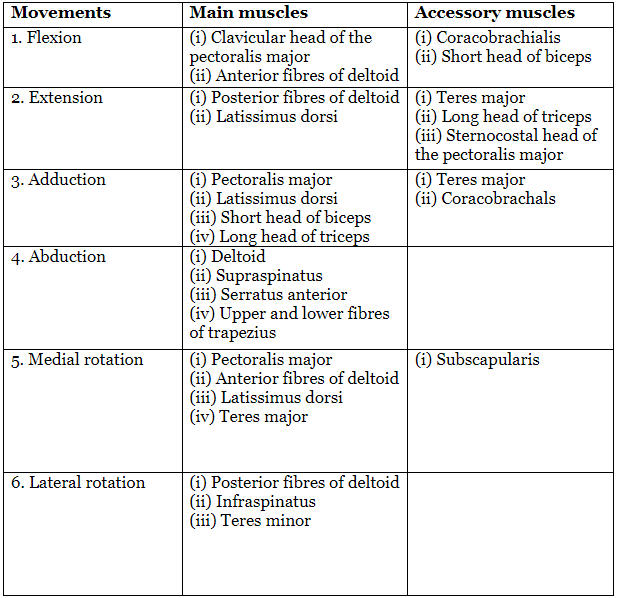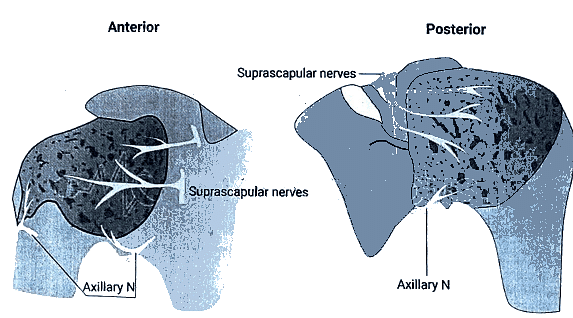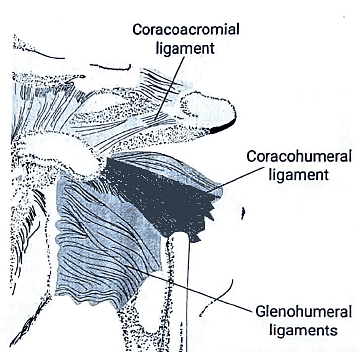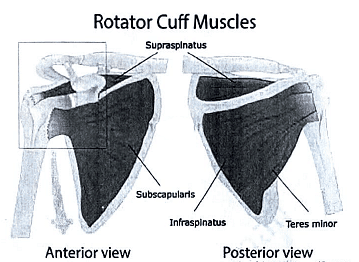Shoulder Joint | Medical Science Optional Notes for UPSC PDF Download
Type of joint
Ball-and-socket synovial joint connecting the humerus head and the glenoid cavity of the scapula.

Topics

Blood supply
- Arteries branching from the axillary artery, namely the anterior and posterior circumflex humeral arteries
- The suprascapular artery, a branch originating from the thyrocervical trunk of the subclavian artery
- Drainage of veins into the subclavian and axillary veins
Nerve supply
- Nerves supplying innervation include the axillary, suprascapular, and lateral pectoral nerves.

Supports
- Capsule: The joint is encased in a fibrous capsule, with superior reinforcement provided by the rotator cuff muscles and the long head of the biceps brachii. Its weakest point is inferiorly.
- Glenoid Labrum: A soft tissue rim surrounds the glenoid fossa of the scapula.
Ligaments
- Coracoacromial Ligament: Stretches from the coracoid process to the acromion process of the scapula, forming the coracoacromial arch. This arch acts as a tunnel, preventing the superior displacement of the humeral head from the glenoid cavity.
- Coracohumeral Ligament: Runs from the coracoid process to the greater and lesser tubercles of the humerus, providing reinforcement to the anterior portion of the joint capsule.
- Glenohumeral Ligament: Reinforces the joint capsule between the supraglenoid tubercle of the scapula and the anatomical neck of the humerus.
- Transverse Humeral Ligament: Extends between the greater and lesser tubercles of the humerus, creating a bridge across the bicipital groove and securing the biceps tendon in place.

Rotator cuff muscles
The tendons of subscapularis, supraspinatus, infraspinatus, and teres minor unite with the lateral aspect of the joint capsule, collectively forming the 'rotator cuff.' These compact muscles work together to generate a compressive force during active glenohumeral movements, ensuring consistent contact between the humeral head and the glenoid fossa. This action helps resist skidding and prevents excessive translation.
Moreover, the rotator cuff contributes robust lateral stability, safeguarding this region of the relaxed capsule from pinching during joint motions.

Rotator Cuff Disease:
The subacromial space is delineated by the humeral head below and the anterior edge, inferior surface of the anterior third of the acromion, coracoacromial ligament, and acromioclavicular joint above, forming the coracoacromial arch. This space accommodates the supraspinatus tendon, subacromial bursa, tendon of the long head of the biceps brachii, and the shoulder joint capsule.
Rotator cuff disease is a painful condition with a multifactorial origin, often characterized by severe or chronic impingement of the rotator cuff tendons against the undersurface of the coracoacromial arch. The impingement typically occurs when the humerus is abducted, flexed, and internally rotated, a position known as the impingement position. The supraspinatus tendon is particularly susceptible to impingement, coinciding with an area of reduced vascularity in this tendon. Thickening of the coracoacromial arch, inflammation from disorders like rheumatoid arthritis, or prolonged overuse in the impingement position, such as during window cleaning, can lead to severe impingement.
Painful Arc Syndrome:
When linked with tendinopathy due to age-related degenerative changes within the tendon, impingement may result in partial or complete tears of the rotator cuff. Clinically, this condition manifests as tenderness over the anterior portion of the acromion and pain typically experienced when abducting the shoulder between 60° and 120°, known as the painful arc.
Frozen Shoulder (Adhesive Capsulitis):
An inflammatory process induces fibroblastic proliferation of the joint capsule, causing thickening, fibrosis, and adherence of the capsule to itself and the humerus. Associated conditions include diabetes, autoimmune thyroiditis, and Dupuytren's contractures. Symmetrical loss of active and passive rotational movements, with external rotation being a common finding, characterizes the clinical presentation of this self-limited disease.
Glenohumeral joint dislocations
- The glenohumeral joint holds the distinction of being the most commonly dislocated joint in the human body.
- Its greatest susceptibility to instability is in the anteroinferior direction, elucidating why the majority of dislocations are anterior. These instances often occur when external force compels the arm into abduction, external rotation, and extension.
- Clinically, a dislocated shoulder deviates from its normal contour, and the acromion process, rather than the greater tubercle, becomes the most lateral bony structure.
- Dislocation poses a risk to the axillary nerve and artery, potentially leading to the inability to abduct the shoulder due to deltoid paralysis. Additionally, there may be an area of anesthesia over the distal part of the muscle, commonly referred to as the 'badge area' of skin, along with ischemic changes in the limb. Posterior dislocations are infrequent and typically result from forceful movements causing pronounced internal rotation and adduction, as seen in conditions such as epileptic seizures or electric shocks.
Shoulder joint-Repeats
- Describe the shoulder joint under the following headings: (2012)
i. Type of joint (Classification of joint)
ii. Movements occurring at this joint
iii. List main ligaments
iv. Name the muscles acting at this joint (Do not describe each muscle)
v. Applied anatomy of dislocation of shoulder joint
vi. What is meant by the term "frozen shoulder"? - Describe the shoulder joint under the following headings (2013)
i. Type
ii. Movements
iii. Muscles
iv. Applied anatomy. - Describe the shoulder joint under the following headings: (2017)
i. Movement
ii. Blood Supply
iii. Ligaments
|
7 videos|236 docs
|
FAQs on Shoulder Joint - Medical Science Optional Notes for UPSC
| 1. What is the shoulder joint and what are its main functions? |  |
| 2. What are the common causes of shoulder joint pain? |  |
| 3. How is shoulder joint pain diagnosed? |  |
| 4. What are the treatment options for shoulder joint pain? |  |
| 5. How can shoulder joint health be maintained? |  |





















